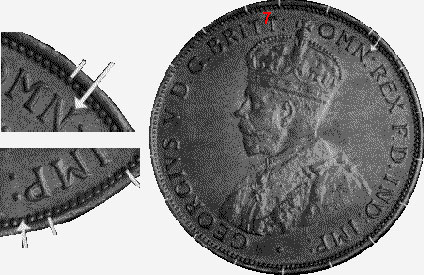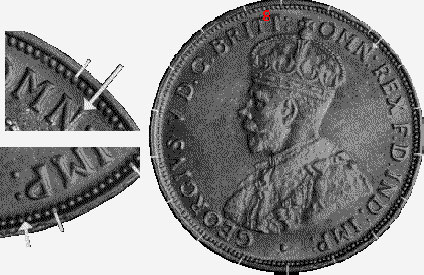King George V Pennies Obverse Die Varieties
By AG | Monday, 24 November 2003
Two obverse die varieties were used throughout the King George V series of Australian pennies between 1911 and 1936. Pennies from 1911 to 1915 were struck at either the Royal Mint, London or at Ralph Heaton & Sons, Birmingham. The London die was used exclusively during these years.
During World War I, a pre-occupation with defence commitments caused a transfer of the production of Australia's bronze coinage to Calcutta, India. The Royal Mint supplied the Calcutta Mint with master dies for Australian pennies and half pennies which were struck there in the three years 1916, 1917 and 1918. The halfpenny die was identical to the London one. The obverse die used by Calcutta for the penny displayed a number of minor variations from its London counterpart and is known as the Indian die. The known differences in the obverse die are shown in the following table.
London Die

- The last stroke of the N in OMN is aligned between rim beads.
- The semicolon after IMP is directly aligned with a rim bead.
- There are 177 beads or denticles inside the rim.
Indian Die

- The last stroke of the N in OMN is directly aligned with a rim bead.
- The semicolon after IMP is aligned between rim beads.
- There are 178 beads or denticles inside the rim.
When the minting of Australian bronze coins was moved to Australia in 1919, all pennies were minted in Melbourne that year using the London die. By 1920, Sydney was also producing pennies and in 1922, Perth struck pennies for that single year. Both the London and Indian dies were used in the years between 1920 and 1931. From 1932, the London die was used exclusively. The following table the dies used and their relative rarity.
- 1911-1915 - London
- 1916-1918 - Indian
- 1919 - London
- 1920 - London (rare) and Indian
- 1921 - London (rare) and Indian
- 1922 - London and Indian
- 1923 - London
- 1924 - London and Indian (scarce)
- 1925 - London and Indian (unconfirmed)
- 1926 - London
- 1927 - London and Indian (rare)
- 1928 - London
- 1929 - London and Indian
- 1930 - London (unconfirmed) and Indian
- 1931 - London and Indian
- 1932-1936 - London




